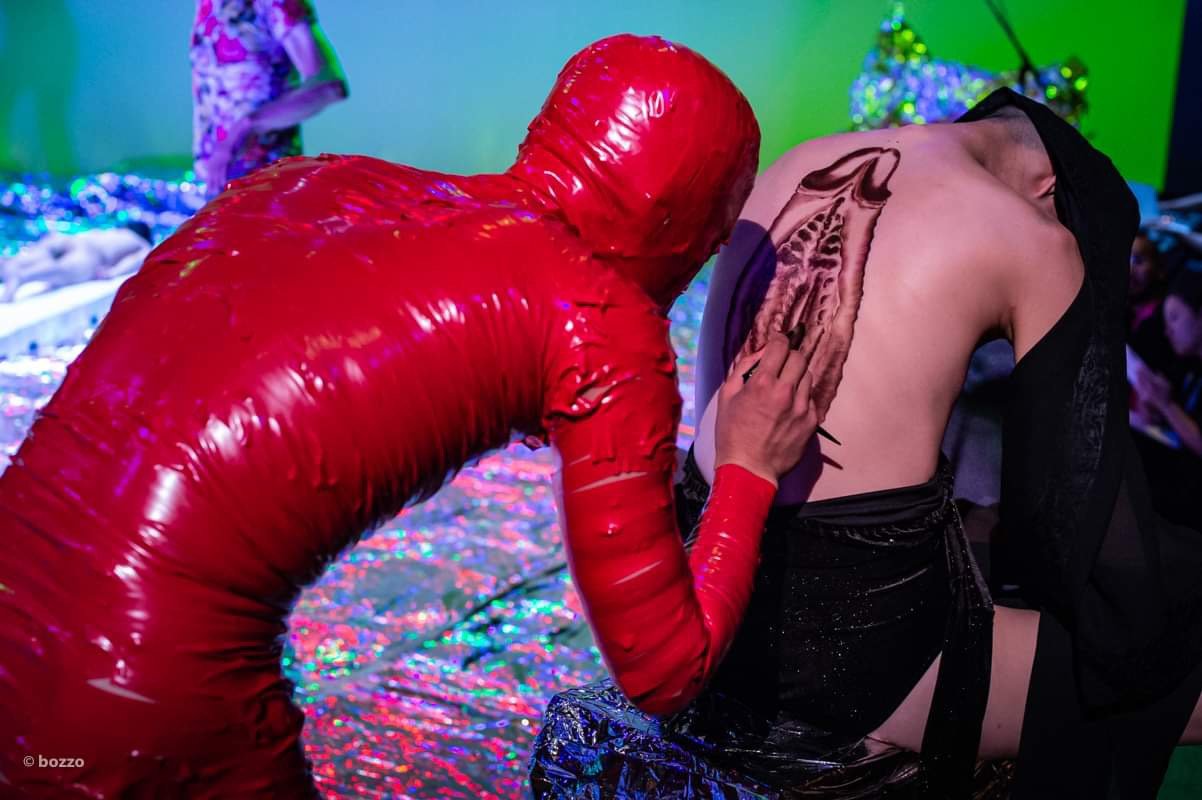AN INTERVIEW WITH KARU MIYOSHI: BODY AS BORDERLINE
Forget the frame. Forget the stage. Forget everything you think performance art should be like.
Welcome to the world of Karu Miyoshi, a Tokyo-based Performance-Artist, who doesn’t just make art - he becomes it. His body is canvas, playground, battlefield. His performances breathe, sweat, and sometimes stumble. And that’s the point.
In one of his recent performances, Karu became the entire space itself. The audience was invited to enter this space; meaning, quite literally, they entered him. Karu embodied the room, extending the concept of skin through fabric and clothing. In doing so, he transformed his body into a permeable environment, allowing others to physically step inside his presence.
GATA Magazine sat down with Karu to talk about improvisation, chaos, and his concept of “now”.
Karu’s art isn’t static. It’s an open loop. A flickering in-between space where people meet, hesitate, react - and maybe even change. This isn’t just about watching. It’s about being there. Or better: being part of it.
“The fat of the place”, Photos by Roun Kim
GATA: Hi Karu, can you give us an overview, who are you and what do you do?
KARU: I was born in Japan in 2001, I work across different media; performance, painting, video, installation and tattoo—depending on what a moment or idea calls for. I present both physical and conceptual questions about where the self begins and ends.
GATA: What would you say is your biggest inspiration or influence?
KARU: It’s difficult to name just one, as I’ve been influenced little by little from various fields. But looking back now, I think the book “I can go to places I can’t see, but it’s hard to go to places I can see” by SHIMABUKU, which I read in high school, had a significant impact on my art. I was struck by how the artist found joy and value in relationships—with people and things—and how he created delicate connections that went beyond the traditional artist–artwork relationship, involving others in the process.





GATA: What was your Idea behind the Exhibition „The fat of the place“ in the Token Art Center?
KARU: This work was created from my interest in expanding the personal space that exists inside clothing. The audience enters the inside of an enlarged piece of clothing to experience the performance. The space is both outside and inside — and at the same time, it’s an ambiguous space that is neither. I also think of clothing as a “second skin,” and I created the piece with the image of sharing and invading that skin.
GATA: How do you approach a project? And how is the process from the initial idea until the actual outcome?
KARU: I usually keep a stock of ideas by writing them down in words or sketching them as they come to me, allowing them to mature over time. I also talk to people about my ideas. Through that process, a general direction starts to take shape.
When it comes to performance, I want to create something that strongly resonates with the place. I often incorporate improvisation during the performance itself. I believe that combining a long-matured idea with what I’m currently thinking or feeling allows me to create a meaningful, new sense of “now.”
GATA: You are mostly always part of your exhibitions, how does it feel? Do people interact with you?
KARU: My performances often blur the line between audience and performer—I resist the traditional division. That closeness creates unexpected moments: people step into risky spaces, interact with me as if we’ve met before, or behave in ways they normally wouldn’t. Describing is hard sometimes, I think you have to be there to understand, haha.
I improvise to respond, but if I’m not the one performing, that spontaneity can drift far from the original concept. That’s why I usually perform myself—to take full responsibility. Still, I’m curious to explore working with others while navigating this unpredictability.
“Medium and Dimension: Apparition” by Shota Yamauchi, Photos by Koichi Nishiyama
GATA: What’s more important in art for you: chaos or precision?
KARU: Both chaos and precision are important to me, but what I enjoy more is chaos. I find it more interesting when a concept has parts that even the artist doesn’t fully understand, rather than being something neatly organized. Recently, I’ve become more interested in places that lie outside my own understanding or areas where I feel doubt. It’s the existence of something that is visually present but not perceived as information.
GATA: What are your future Plans or Projects? Anything you want to share?
KARU: This summer, I will be performing a piece called “Gigantic Soccer.” It’s a performance featuring a soccer match between two giants. People are inside gigantic balls, and the two giants kick these balls against each other to compete for points. Each giant is made up of different parts—hands, feet, and torso—where a person is inside each part, and five people work together to move the giant. The performance contrasts the body inside the ball, which has no agency, with the body of the giant, whose agency is distributed among five people.
GATA: That sounds crazy. Can´t wait! Thank you Karu!
“The Soles of a mermaids feet, on the earth, among thorns”, Photo by Sae Sugie






